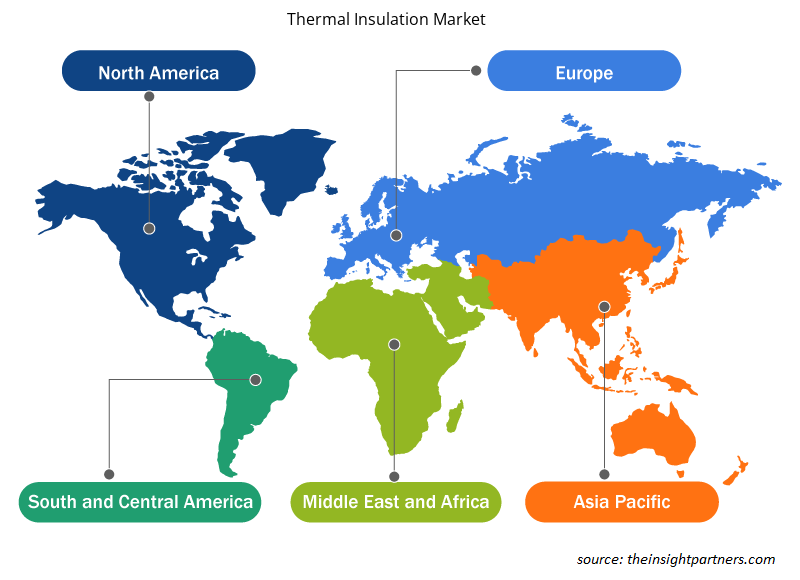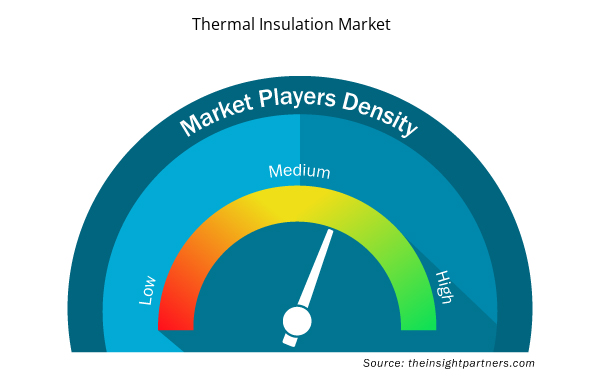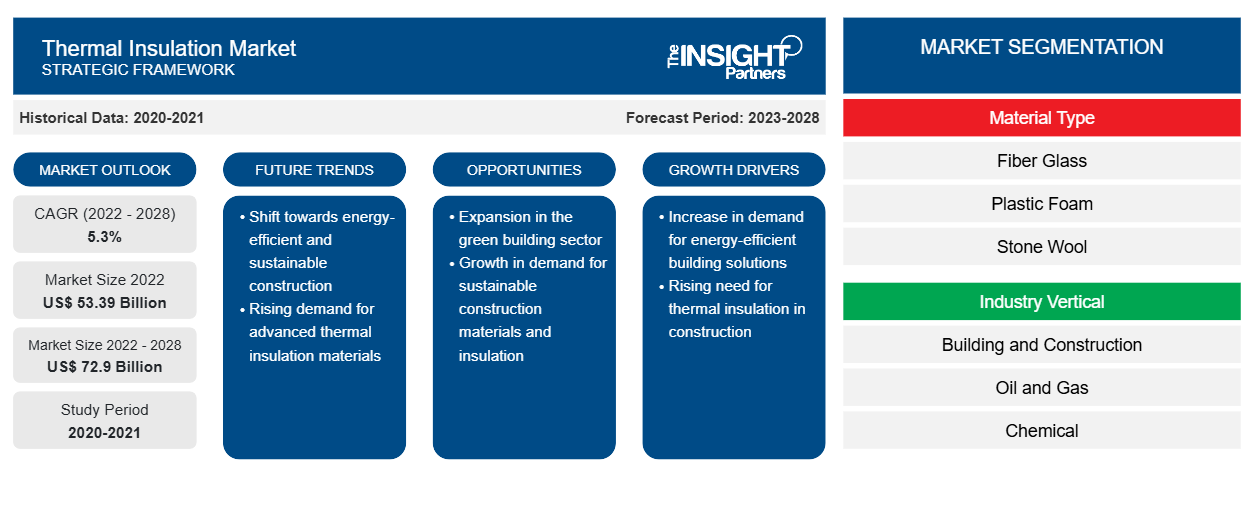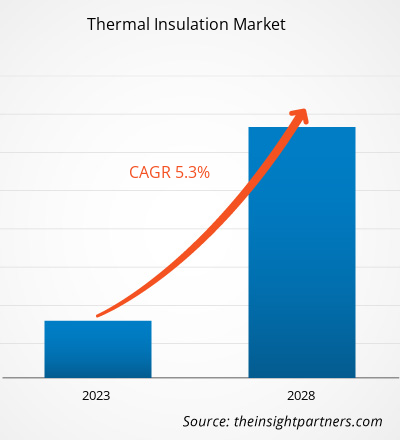隔热市场预计将从 2022 年的 533.9 亿美元增长到 2028 年的 729.0 亿美元;预计 2022 年至 2028 年的复合年增长率为 5.3%。
由于隔热材料具有诸多优点,因此对隔热材料的需求有所增加。它降低了能源成本,并减少了两个不同温度物体之间的热传递。隔热材料提供隔热功能,可以反射、减少和吸收辐射热。公司专注于提供塑料等轻质产品,因为它易于安装,需要的时间和精力更少。这些因素预计将促进隔热市场的增长。
由于 BASF SE、Bayer AG、ROCKWOOL A/S、Johns Manville、SAINT GOBAIN SA、Kingspan Group PLC、Dow Chemicals Company、Owens Corning、Asahi Kasei Corporation 和 DuPont 等知名企业的强势参与,预计未来几年隔热市场将出现大幅增长。各种各样的隔热产品引起了消费者的关注。人们越来越意识到高温隔热的好处,包括耐高温和热冲击、低导热性、环境效益和成本效益,这可能会在预测期内推动隔热市场的增长。
2021 年,亚太地区占据全球隔热市场的最大份额。然而,预计北美在预测期内的市场复合年增长率最高。亚太市场分为中国、印度、澳大利亚、日本、韩国和亚太其他地区。由于人口迅速增加,建筑业是亚太地区蓬勃发展的行业之一;这最终导致对隔热产品的需求旺盛。此外,消费者可支配收入水平的提高和中产阶级人口的增长是推动该地区隔热市场增长的一些关键因素。
定制此报告以满足您的需求
您可以免费定制任何报告,包括本报告的部分内容、国家级分析、Excel 数据包,以及为初创企业和大学提供优惠和折扣
- 获取此报告的关键市场趋势。这个免费样品将包括数据分析,从市场趋势到估计和预测。
COVID-19 疫情对隔热材料市场的影响
在新冠疫情爆发之前,隔热材料市场的增长主要由建筑和建筑活动需求的增加所推动。然而,由于企业停工、原材料和劳动力短缺以及建筑和运输活动减少,市场在 2020 年第一季度面临障碍。新冠疫情导致 2020 年头几个月出现经济衰退,给低收入和中等收入消费者带来了财务困难。
此外,由于限制措施,许多建筑公司和制造业停工,影响了隔热市场的增长。此外,在疫情期间,劳动力短缺是隔热行业的主要担忧。这导致隔热行业转向机械化、自动化和异地制造。
市场洞察
使用隔热材料的好处
隔热可减少热量移动和蒸汽凝结。因此,它可以防止建筑物中可能出现的潮湿、霉菌、冻结、变形以及铁部件因腐蚀而变弱;并有助于保护建筑物。此外,在各个行业中,通过使用 BTU-BLOCK 隔热材料等产品,可以降低衬砌结构的导热性,从而获得巨大的节能效益。
根据材料类型,全球市场分为玻璃纤维、塑料泡沫、岩棉、硅酸钙、泡沫玻璃等。2021 年,玻璃纤维部分占收入份额最大,塑料泡沫预计在预测期内增长率最高。按行业垂直划分,全球市场分为建筑和施工、石油和天然气、化工、航空航天和国防、汽车、制药等。建筑和施工部分占收入份额最大。
巴斯夫 SE、拜耳股份公司、洛科威 A/S、Johns Manville、圣戈班 SA、Kingspan Group PLC、陶氏化学公司、欧文斯科宁、旭化成株式会社和杜邦是隔热材料市场中的几家主要参与者。这些公司为市场提供了广泛的产品组合。这些公司在发展中地区都有业务,提供了有利可图的市场机会。市场参与者正在开发高质量、创新的产品以满足客户要求。
报告亮点
- 市场上不断发展的行业趋势,帮助参与者制定有效的长期战略
- 发达市场和发展中市场采用的业务增长战略
- 2022 年至 2028 年隔热产品市场规模定量分析
- 全球隔热材料需求量估计
- PEST 分析可说明行业内买家和供应商的效率
- 了解竞争市场状况的最新发展
- 市场趋势和前景以及推动和抑制隔热市场增长的因素
- 通过强调支撑商业利益的市场策略来协助决策过程,从而促进市场增长
- 不同节点的隔热市场规模
- 市场的详细概述和细分,以及隔热行业动态
- 各地区隔热保温市场规模及增长机遇
隔热材料市场区域洞察
Insight Partners 的分析师已详细解释了预测期内影响隔热市场的区域趋势和因素。本节还讨论了北美、欧洲、亚太地区、中东和非洲以及南美和中美洲的隔热市场细分和地理位置。

- 获取隔热市场的区域特定数据
隔热市场报告范围
| 报告属性 | 细节 |
|---|---|
| 2022 年市场规模 | 533.9亿美元 |
| 2028 年市场规模 | 729亿美元 |
| 全球复合年增长率(2022 - 2028) | 5.3% |
| 史料 | 2020-2021 |
| 预测期 | 2023-2028 |
| 涵盖的领域 | 按材料类型
|
| 覆盖地区和国家 | 北美
|
| 市场领导者和主要公司简介 |
|
隔热市场参与者密度:了解其对业务动态的影响
隔热材料市场正在快速增长,这得益于终端用户需求的不断增长,而这些需求又源于消费者偏好的不断变化、技术进步以及对产品优势的认识不断提高等因素。随着需求的增加,企业正在扩大其产品范围,进行创新以满足消费者的需求,并利用新兴趋势,从而进一步推动市场增长。
市场参与者密度是指在特定市场或行业内运营的企业或公司的分布情况。它表明在给定市场空间中,相对于其规模或总市场价值,有多少竞争对手(市场参与者)存在。
在隔热材料市场运营的主要公司有:
- 巴斯夫
- 拜耳公司
- 洛科威公司
- 约翰斯·曼维尔
- 圣戈班公司
免责声明:上面列出的公司没有按照任何特定顺序排列。

- 了解隔热材料市场的主要参与者概况
“2028 年隔热市场分析”是一项针对消费品行业的专业深入研究,特别关注全球隔热市场趋势分析。该报告旨在提供市场概况,并进行详细的市场细分。
隔热材料市场按材料类型、垂直行业和地域划分。根据材料类型,全球市场分为玻璃纤维、塑料泡沫、岩棉、硅酸钙、泡沫玻璃等。根据垂直行业,全球市场分为建筑和施工、石油和天然气、化工、航空航天和国防、汽车、制药等。按地域划分,市场大致分为北美、欧洲、亚太地区 (APAC)、中东和非洲 (MEA) 以及南美和中美。
公司简介
巴斯夫公司、拜耳公司、洛科威公司、Johns Manville、圣戈班公司、金斯潘集团、陶氏化学公司、欧文斯康宁、旭化成公司和杜邦公司是全球隔热材料市场的知名企业。
- 历史分析(2 年)、基准年、预测(7 年)及复合年增长率
- PEST 和 SWOT 分析
- 市场规模价值/数量 - 全球、区域、国家
- 行业和竞争格局
- Excel 数据集



Report Coverage
Revenue forecast, Company Analysis, Industry landscape, Growth factors, and Trends

Segment Covered
This text is related
to segments covered.

Regional Scope
North America, Europe, Asia Pacific, Middle East & Africa, South & Central America

Country Scope
This text is related
to country scope.
常见问题
Based on the industry vertical, building and construction segment accounted for the highest share of the global market in 2021. Thermal insulation materials are increasingly used in the building and construction sector as they slow heat transfer through the enclosure to reduce heat gain and loss. Thermal insulation is increasingly becoming an essential technology to reduce energy consumption in buildings by preventing heat gain/loss through the building envelope.
Increasing demand for high-temperature thermal insulation is a recent trend in the global thermal insulation market. Growing awareness about the benefits of high-temperature insulation, including resistance to elevated temperatures and thermal shocks, low thermal conductivity, environmental benefits, and cost efficiency, is likely to propel the thermal insulation market growth over the forecast period. In addition, thermal insulation can protect equipment and help achieve extraordinarily high or low temperatures with reduced accident risks.
Based on the material type, plastic foam is expected to be the fastest-growing segment during the forecast period. Plastic foams are a type of polymer that includes voids and cells within the polymers. It is a lightweight cellular foam that is increasingly used as an insulation material.
Increase in demand for lightweight thermal insulation and growth in the building and construction industry are drivers of thermal insulation. Thermal insulation material offers insulation in which the radiative heat is reflected, reduced, and absorbed. Thermal insulation is a powerful technology that is used to reduce energy consumption in buildings by preventing heat gains or losses through the building covering.
The major players operating in the global thermal insulation market BASF SE, Bayer AG, ROCKWOOL A/S, Johns Manville, SAINT GOBAIN S.A, Kingspan Group PLC, Dow Chemicals Company, Owens Corning, Asahi Kasei Corporation, and DuPont.
In 2021, Asia Pacific accounted for the largest share of the global thermal insulation market. The Asia Pacific thermal insulation market is segmented into China, India, Japan, South Korea, Australia, and the Rest of Asia Pacific. These countries are witnessing growth in various end-use industries which will boost the growth of the thermal insulation market in the region. Growing urbanization in the emerging economies of Asia Pacific has led to an increased requirement for better commercial and public infrastructure. Rural-to-urban migration in developing countries in the region is increasing the construction activity in urban areas. As urban buildings are usually more insulation intensive than those in rural areas, this will, in turn, stimulate demand for thermal insulation in residential buildings.
Trends and growth analysis reports related to Chemicals and Materials : READ MORE..
The List of Companies - Thermal Insulation Market
- BASF SE
- Bayer AG
- ROCKWOOL A/S
- Johns Manville
- SAINT GOBAIN S.A
- Kingspan Group PLC
- Dow Chemicals Company
- Owens Corning
- Asahi Kasei Corporation
- DuPont
The Insight Partners performs research in 4 major stages: Data Collection & Secondary Research, Primary Research, Data Analysis and Data Triangulation & Final Review.
- Data Collection and Secondary Research:
As a market research and consulting firm operating from a decade, we have published and advised several client across the globe. First step for any study will start with an assessment of currently available data and insights from existing reports. Further, historical and current market information is collected from Investor Presentations, Annual Reports, SEC Filings, etc., and other information related to company’s performance and market positioning are gathered from Paid Databases (Factiva, Hoovers, and Reuters) and various other publications available in public domain.
Several associations trade associates, technical forums, institutes, societies and organization are accessed to gain technical as well as market related insights through their publications such as research papers, blogs and press releases related to the studies are referred to get cues about the market. Further, white papers, journals, magazines, and other news articles published in last 3 years are scrutinized and analyzed to understand the current market trends.
- Primary Research:
The primarily interview analysis comprise of data obtained from industry participants interview and answers to survey questions gathered by in-house primary team.
For primary research, interviews are conducted with industry experts/CEOs/Marketing Managers/VPs/Subject Matter Experts from both demand and supply side to get a 360-degree view of the market. The primary team conducts several interviews based on the complexity of the markets to understand the various market trends and dynamics which makes research more credible and precise.
A typical research interview fulfils the following functions:
- Provides first-hand information on the market size, market trends, growth trends, competitive landscape, and outlook
- Validates and strengthens in-house secondary research findings
- Develops the analysis team’s expertise and market understanding
Primary research involves email interactions and telephone interviews for each market, category, segment, and sub-segment across geographies. The participants who typically take part in such a process include, but are not limited to:
- Industry participants: VPs, business development managers, market intelligence managers and national sales managers
- Outside experts: Valuation experts, research analysts and key opinion leaders specializing in the electronics and semiconductor industry.
Below is the breakup of our primary respondents by company, designation, and region:

Once we receive the confirmation from primary research sources or primary respondents, we finalize the base year market estimation and forecast the data as per the macroeconomic and microeconomic factors assessed during data collection.
- Data Analysis:
Once data is validated through both secondary as well as primary respondents, we finalize the market estimations by hypothesis formulation and factor analysis at regional and country level.
- Macro-Economic Factor Analysis:
We analyse macroeconomic indicators such the gross domestic product (GDP), increase in the demand for goods and services across industries, technological advancement, regional economic growth, governmental policies, the influence of COVID-19, PEST analysis, and other aspects. This analysis aids in setting benchmarks for various nations/regions and approximating market splits. Additionally, the general trend of the aforementioned components aid in determining the market's development possibilities.
- Country Level Data:
Various factors that are especially aligned to the country are taken into account to determine the market size for a certain area and country, including the presence of vendors, such as headquarters and offices, the country's GDP, demand patterns, and industry growth. To comprehend the market dynamics for the nation, a number of growth variables, inhibitors, application areas, and current market trends are researched. The aforementioned elements aid in determining the country's overall market's growth potential.
- Company Profile:
The “Table of Contents” is formulated by listing and analyzing more than 25 - 30 companies operating in the market ecosystem across geographies. However, we profile only 10 companies as a standard practice in our syndicate reports. These 10 companies comprise leading, emerging, and regional players. Nonetheless, our analysis is not restricted to the 10 listed companies, we also analyze other companies present in the market to develop a holistic view and understand the prevailing trends. The “Company Profiles” section in the report covers key facts, business description, products & services, financial information, SWOT analysis, and key developments. The financial information presented is extracted from the annual reports and official documents of the publicly listed companies. Upon collecting the information for the sections of respective companies, we verify them via various primary sources and then compile the data in respective company profiles. The company level information helps us in deriving the base number as well as in forecasting the market size.
- Developing Base Number:
Aggregation of sales statistics (2020-2022) and macro-economic factor, and other secondary and primary research insights are utilized to arrive at base number and related market shares for 2022. The data gaps are identified in this step and relevant market data is analyzed, collected from paid primary interviews or databases. On finalizing the base year market size, forecasts are developed on the basis of macro-economic, industry and market growth factors and company level analysis.
- Data Triangulation and Final Review:
The market findings and base year market size calculations are validated from supply as well as demand side. Demand side validations are based on macro-economic factor analysis and benchmarks for respective regions and countries. In case of supply side validations, revenues of major companies are estimated (in case not available) based on industry benchmark, approximate number of employees, product portfolio, and primary interviews revenues are gathered. Further revenue from target product/service segment is assessed to avoid overshooting of market statistics. In case of heavy deviations between supply and demand side values, all thes steps are repeated to achieve synchronization.
We follow an iterative model, wherein we share our research findings with Subject Matter Experts (SME’s) and Key Opinion Leaders (KOLs) until consensus view of the market is not formulated – this model negates any drastic deviation in the opinions of experts. Only validated and universally acceptable research findings are quoted in our reports.
We have important check points that we use to validate our research findings – which we call – data triangulation, where we validate the information, we generate from secondary sources with primary interviews and then we re-validate with our internal data bases and Subject matter experts. This comprehensive model enables us to deliver high quality, reliable data in shortest possible time.


 获取此报告的免费样本
获取此报告的免费样本